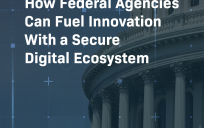This post is an excerpt from our recent report, “Platform & Infrastructure as a Service: Creating New Efficiencies.” To download the full report, click here. The report is part of a three-part series, where GovLoop will highlight the power of the Oracle cloud and explore how Oracle is helping government agencies transform the way they deliver services.
With PaaS, agencies place much more responsibility to manage the cloud stack on the provider, which gives more value and flexibility to the agency. PaaS is an essential development for government, as it’s an efficient way to leverage middleware and databases to host applications.
PaaS helps organizations gain the following:
- Increased capacity for provisioning against physical servers.
- Optimized application to server ratios and the ability to turn off spare capacity.
- Improved monitoring of services and proactive alerting.
“A lot of people ask, does PaaS mean I don’t need database administrators (DBAs) anymore?” noted Mark Johnson, Information Technology Strategy Expert at Oracle. “You’re still going to need DBAs, but those DBAs are now going to be concentrating on adding value to the applications of the agency. They’re not going to be just doing the simple stuff like patching the database and backing it up. That’s what the cloud service provider’s going to bring – and that’s much more robust than just an infrastructure provider.”
As more organizations start to use PaaS, agency IT teams will be freed up to work on more mission critical problems, as a vendor will manage complex IT elements, set up middleware, and provide smaller agencies with Enterprise-class IT systems, even with limited IT staff.
“IT management is now much easier with PaaS,” said Johnson. “Since agencies offload more management to the cloud service provider in a PaaS environment, all the agency has to provide is the functionality for a particular application. That’s very high value, and gets people excited when they start talking about cloud and benefits it can bring to them.”
There are many benefits to leveraging PaaS, but one of the major ones is a larger reduction in cost than with just IaaS. As the graphic on the previous page shows, Hardware and Facilities costs make up less than 20% of most IT Program Costs, and these are the only costs that IaaS can affect. PaaS solutions can provide those savings, but more significantly, address the Implementation and Management costs that make up over 70% of IT program expenses. The savings in PaaS often come from consolidating resources, and reducing – or in many cases, eliminating – redundant work done by employees.
PaaS also offers customers the ability to rapidly host, test and produce applications. When a developer wants to test an application, PaaS can instantly deliver a complete application environment ready for whatever is needed. And if there is high demand for an application, PaaS can scale more efficiently to meet user demands. Infrastructure leaves much of the complex IT work to the agency, whereas PaaS offers new capabilities that governments want to use, but don’t want to try to setup or maintain.
Finally, security certifications are more robust with PaaS than with IaaS. Infrastructure providers with certifications like FedRAMP only provide security at the very bottom of the solution stack, leaving 90 percent or more of the security work to the user. PaaS can extend much further up, and simplify the overall process of creating and maintaining a secure cloud environment.





PaaS is such an IMPORTANT CONCEPT that I feel people are now just starting to comprehend. Love the post. Would love to talk to anyone who is interested in learning how this concept could be applied to their program as my company has been championing this concept within the USMC for the past couple of years…good stuff as always Catherine!